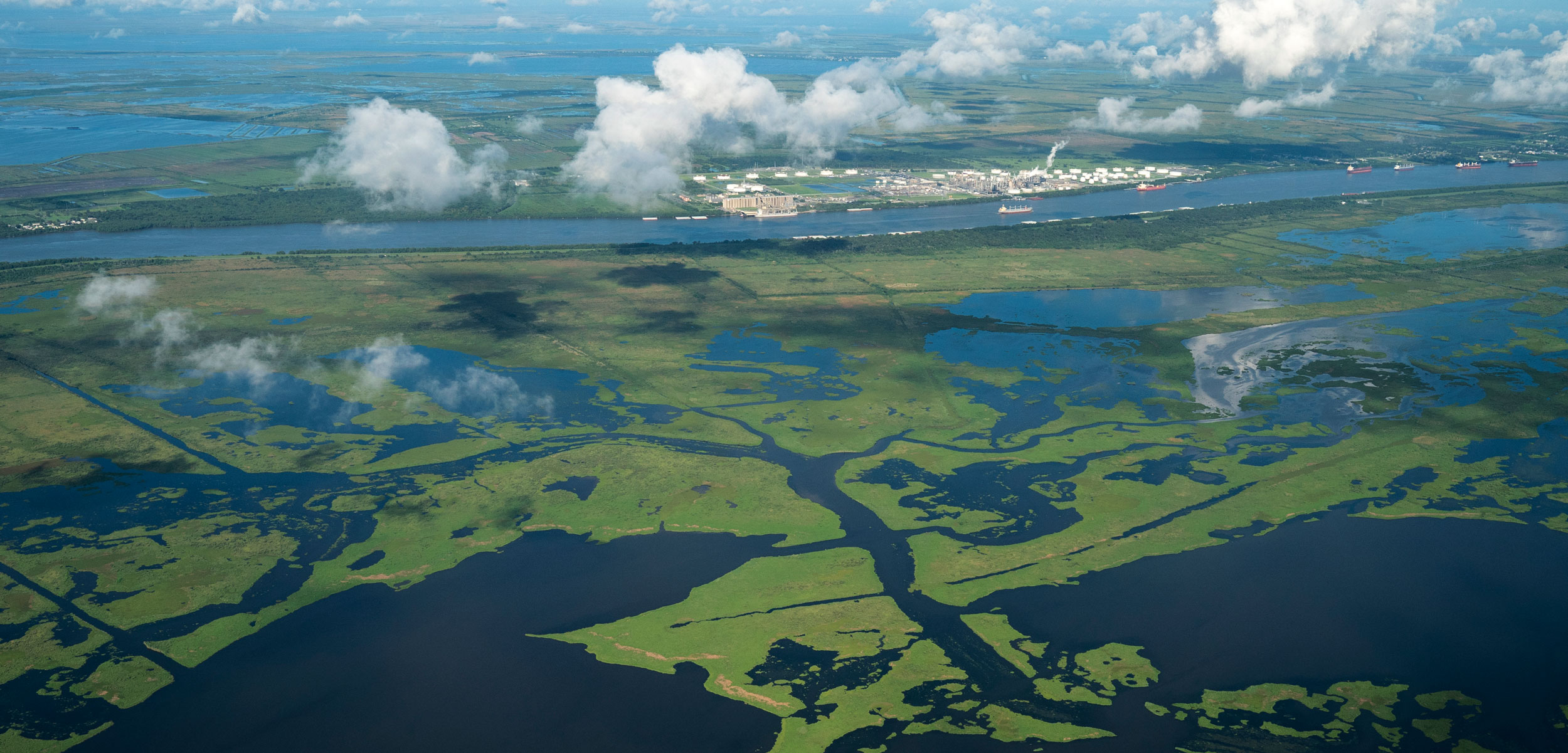
The idea of formal property rights in a flood plain has always been absurd, except it can take a thousand years to work out. A better system needs to deal in mobile land credits.
Still a problem, but it is something the insurance industry can get around.
What is sure is that levees will need to be changed out allowing active flooding all through the whole basin.
If we build on flood zones with some wisdom in avoiding wash out zones, we can live with it all and work the land ownership to allow land credits so that land users can replace land lost to a shifting river bed. We certsainly have the capacity to shove mud around...
A history of levee construction has resulted in significant land loss along the Mississippi River Delta in Louisiana. Plans to reroute some of the river sediment will have direct impacts on the communities in Plaquemines Parish, located along the river’s final stretch. Photo by Drew Angerer/Getty Images
The Controversial Plan to Unleash the Mississippi
Our long history of constraining the river through levees has led to massive land loss in its delta. Can we engineer our way out? And at what cost?by Boyce Upholt
July 12, 2022 | 5,300 words, about 26 minutes
Share this:
This article is also available in audio format. Listen now, download, or subscribe to “Hakai Magazine Audio Edition” through your favorite podcast app.
The creation story told by the Chitimacha people, in Louisiana, describes the world in its earliest days as a wide expanse of water. Then the Great Creator instructed crawfish to dive down and bring up a bit of mud. Geologists tell a similar tale, though their sculptor is the Mississippi River: for thousands of years, it dumped soils stolen off the continent into the Gulf of Mexico. Thus the river formed its delta, a vast and muddy and ever-changing landscape, where the water once forked into many paths to the sea.
These days, though, the river is largely restricted to one channel. Imprisoned within artificial levees, it’s no longer able to deposit its mud according to hydrological whim; instead, the river spits its sediment into the abyss of the deep sea. The consequences are grim: The existing mudscape is sinking. The ocean is rising. Over the past nine decades, more than 5,000 square kilometers of delta land in Louisiana has disappeared.
Few places are going faster than Plaquemines Parish, which encompasses the muddy land along the river’s final 100 or so kilometers, where New Orleans’ exurbs give way to a smattering of rural communities. (A parish is the local equivalent of a county, a remnant of Louisiana’s French colonial history.) One morning last summer, as we weave in his skiff through the parish’s marshland, Richie Blink tells me that the federal government has recently deleted 30-odd names from local nautical maps. Fleur Pond, Dry Cypress Bayou, Tom Loor Pass, Skipjack Bay: all have become undifferentiated, unlabeled expanses of open ocean.
Streaks of brown sediment flow from outlets along one branch of the Mississippi River’s delta. Authorities hope that breaking another hole in the levee nearby will help the river rebuild lost land. Photo by Tsado/Alamy Stock Photo
Now, the state government wants to open a gap in the levee to divert some of the river’s muddy water back into the marshes, allowing the river to resume its old task of construction. Work on the gap could begin in early 2023, assuming, that is, that the US Army Corps of Engineers, the federal agency that oversees waterway infrastructure, grants its official approval later this year. The Mid-Barataria Sediment Diversion—which is named for Barataria Bay, where the released river water will build a new “sub-delta”—has been under discussion for years, but now, on the eve of destruction, it’s come under a firestorm of criticism from shrimpers worried about their livelihood; from homeowners concerned about flooding; and from environmentalists dismayed at the potential loss of bottlenose dolphins, a federally protected species. The diversion is intended to build new marshland, but it’s sometimes depicted as the latest assault on the region’s rural communities—which, according to critics, are about to be sacrificed again for the sake of nearby urban New Orleans.
Blink, an ecotour guide, serves on the Plaquemines Parish council and is the sole member who has not voted to oppose the project. “We are facing these massive changes,” he tells me as the solid ground disappears behind us and we speed into open water. Either the diversion will alter the ecosystem, or the loss of land will. One way or another, the parish will have to do something new if it wants to survive. “We have to imagine this delta of the future,” he says.
It strikes me, though, that we’ve often failed to imagine the delta of the present. Despite all the focus on land loss and land building, we rarely pause to discuss what we mean by land. And here in Louisiana, land—and who should control it—is a sometimes squishy idea.
The Mississippi River is truly massive, combining three major tributaries that together drain 32 US states and two Canadian provinces, from Alberta to New York to New Mexico. Together, these various tributaries once sent as much as 290 million tonnes of dirt to the Gulf of Mexico each year, stacking it into an ever-growing lobe of land. Eventually, the lobe would grow so long that one of the side channels forking away from the river would become a tempting shortcut for the Mississippi. Lured away, the river jumped—or avulsed, in the parlance of geology—on a roughly millennial schedule, sending its torrent of water down one of these channels, building in a new direction.
The Mississippi River, shown in darker blue, is fed by tributaries from multiple states and provinces. Covering 3.2 million square kilometers, this watershed represents the largest drainage basin in North America. Visualization by Horace Mitchell/NASA’s Scientific Visualization Studio
This process has yielded a branching network of overlapping sub-deltas that reach like splayed fingers into the Gulf of Mexico. Each sub-delta holds at its center a line of water, an active or abandoned channel of the Mississippi River. The highest ground, rarely more than a few meters above sea level, sits next to these channels; this is where the most mud has been deposited. These “ridges” can stretch for more than 150 kilometers, though they’re just a few kilometers wide. The modern Plaquemines Parish sub-delta began forming perhaps 750 years ago, and was still under construction when French explorers arrived in the late 17th century. The place seemed to consist “of nothing more than two narrow strips of land, about a musket shot in width,” one member of the crew wrote. Over the next century, French settlers marked the growth of the parish by noting how far the riverbank extended past a fort they’d built at the river’s mouth.
A second type of landform stretches like webbing between the fingers: the marshland that makes up most of the coastal landscape. Here, the mud never stacked high enough to break the ocean surface, but it came close enough to allow marsh grass to root. It’s a world of rich organic soils, though rather unsteady: in places, mats of plants float atop the water, unattached to the soils below, so that if you step onto the grass, it will wobble and sink. The delta begins roughly 500 kilometers upstream of the river’s mouth, and as of 1930, covered nearly 20,000 square kilometers—an area almost the size of New Jersey.
The water running through the marshes is fresh inland and grows saltier closer to the sea. Many species—blue crabs, white shrimp—move across this gradient throughout their life cycles, and the marsh, as a result, offers an abundance of life. The ever-shifting landscape makes research difficult, but evidence suggests that people arrived on the ridges even as they were forming, perhaps to establish short-term hunting and fishing camps amid the new marsh.
The colonial records are somewhat sparse when it comes to Indigenous life within the delta. The first French explorers noted various groups, including the Quinipissa, the Yakni-Chito, the Washa, the Chawasha, and the Chitimacha. Archaeological evidence suggests that at the time of contact, people lived in small villages mostly focused on gathering fish and other wetland resources. The delta was an important crossroads, linking coastal travelers with upriver communities; French explorers noted that so many canoes had been dragged across one ridge-top portage that they had produced a “rather good road.” The Choctaw, one of the larger tribes on the land that would become the US South, called this spot, or perhaps the whole delta, Bulbancha—the place of other languages.
The arrival of European settlers brought disease and slave raids and warfare, and by the time the French began keeping solid records in the 18th century, some Indigenous nations had disappeared, the survivors integrating with neighboring tribes. Some groups slipped into corners of the delta rarely traversed by colonists. People from various villages and traditions settled together, and today the US government refuses to officially recognize some of these groups as tribes, since there is no written record of their beginnings.
European settlers seemed not to know what to make of this landscape, which was far larger and muddier than any delta they’d known. One 18th-century French cartographer depicted a large swath as a blank mass, noting it as “trembling land and swamp”; 120 years later, a surveyor from the US Army made his opinion clearer by pointedly declining to enumerate the marshland’s features. A list of the “multitudinous islands and sheets of water would add nothing” to his description of Plaquemines Parish, the surveyor wrote.
The marshes become something of a no man’s land—or perhaps it’s better to say an every person’s land. In the late 18th century, a group of runaways escaping slavery set up an armed camp in the marsh to the east of New Orleans that could be accessed only by wading through chest-deep water, pushing through the reeds. The Maroons, as they were known, lived alongside Filipino immigrants, who occupied stilt villages three meters above the water and processed dried shrimp by dancing atop the shells. Immigrants from the Canary Islands settled nearby, too. Historians estimate that at the dawn of the 20th century, 150,000 people lived in 200 communities scattered across the delta’s marshlands. These marsh dwellers made their living by fishing, mostly, sometimes trapping raccoons and muskrats for furs.
Then, in the 1920s, oil was discovered beneath the marshes. Surveyors began to trudge through, sinking to their chests in the soft soils, assessing the prospects of this land that was barely land. Some Indigenous residents, unable to read English, signed papers they believed would affirm their ownership. Instead, they were quitting their claims. Today, 90 percent of southern Louisiana is corporate-owned. In places, permanent homes are now outnumbered by “fishing camps”—a catch-all term for coastal vacation homes, though one that implies a false rusticity. Camps often have modern amenities, and some feature lavish architecture.
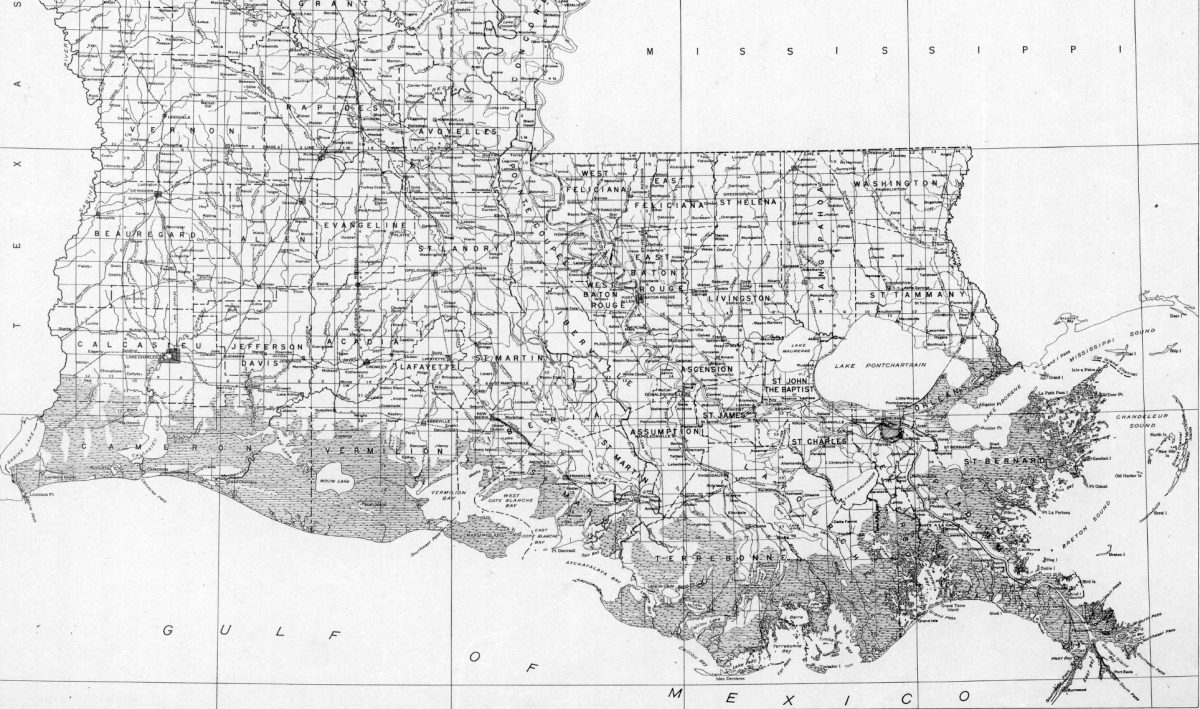
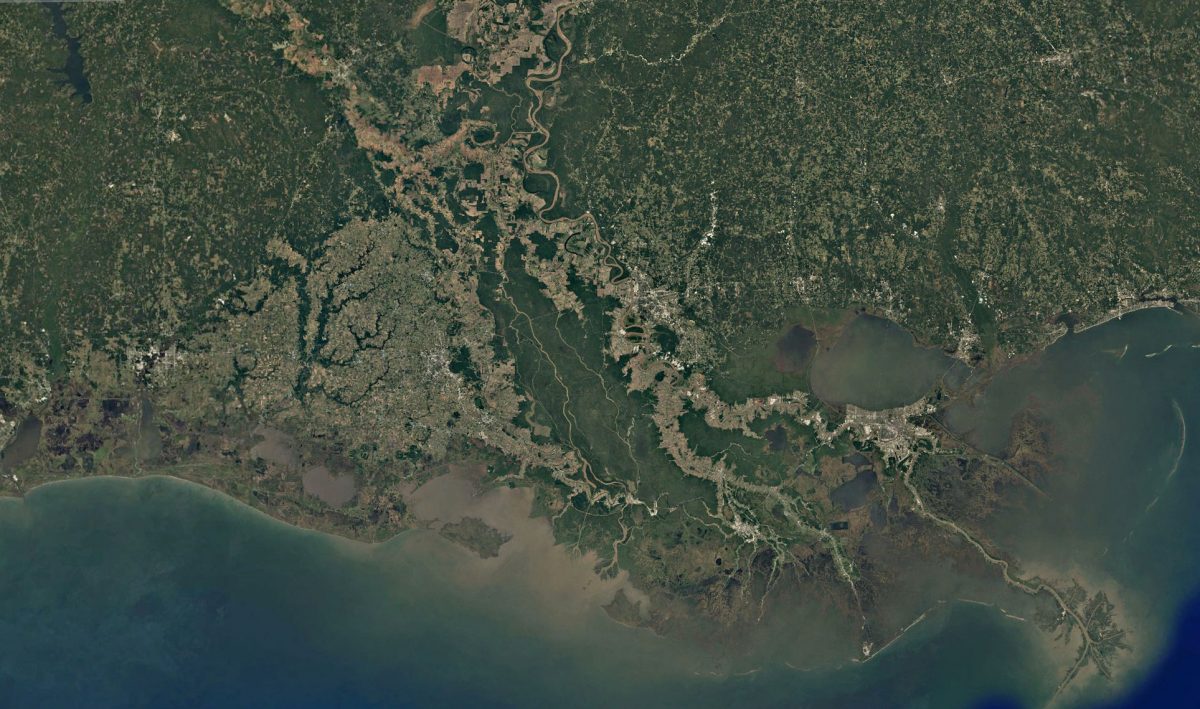
1922
Comparing a map of the Mississippi in 1922 with a more recent image from 2014 illustrates land subsidence along the river’s final reaches. 1922 map by USGS via Louisiana State University, 2014 photo by Landsat/Copernicus/Google Earth
These camps tend to be clustered in marinas, often just beyond the point where the ridge drops away into marsh. Most modern settlement has occurred atop the ridges themselves, which feature the only viable tracts of farmland in the delta. New Orleans was founded in 1718 atop the ridge that runs alongside the current channel of the Mississippi, 150 kilometers upstream of the river’s mouth. The city’s earliest residents found that even this land was precarious. Within the settlement’s first year, the river’s spring rise sent water streaming through the half-finished buildings. The colony’s commander general ordered the construction of a levee, a mound of earth, knee-high, piled along the edge of the river. It was the first small step in a long quest to tame the Mississippi.
Other levees were built along the river through the decades until they merged into a single entity that stretches thousands of kilometers north—well beyond the top of the delta, all the way into southern Missouri, where the Mississippi’s big tributaries join together. By the 20th century, engineers were closing the gaps in the levee that had allowed water to pour out into the delta’s forking streams. They presumed this would reduce flooding by helping the water speed toward the sea.
In the 1950s, engineers confronted another problem: the river was beginning to avulse once more. More and more of its water was pouring into the Atchafalaya River, the last unclosed outlet, aside from the river’s mouth. Scientists realized the Atchafalaya could soon steal the Mississippi’s might; the final 500 kilometers of the river would shrivel into a brackish creek—a big problem, given that New Orleans relies on the river for drinking water. A set of gates was installed to halt that jump.
By then, there had been a few cries of alarm about disappearing land. A note in National Geographic in 1897 indicated that an old Spanish magazine at the river’s mouth had sunk roughly 30 centimeters over 20 years. In the 1940s, a writer noted that the back edges of many plantations built along the riverbanks were slumping into the water. Both accounts blamed the levee for the problem. The state government investigated land loss in the 1950s and found the ocean was creeping inland by as much as 19 meters per year. But the focus of the survey was more economic than scientific—the state government was in a dispute with the federal government over where the offshore seabed, and its lucrative oil deposits, turned into federal property—and few ecologists expressed alarm. The prevailing wisdom seemed to be that, on the whole, the delta would survive. After all, it had already persisted for thousands of years.
Then, in the 1960s, Texas officials asked for the Mississippi’s water to be diverted west, toward that state’s drought-stricken plains. Since this would reduce the river’s flow to the coast, a team of researchers at Louisiana State University (LSU) began to investigate potential side effects. The team rediscovered the ongoing crisis of land loss. Once more, scientists blamed levees, though they also acknowledged the damage caused by oil companies. Companies had dredged canals to reach sites where they drilled for oil and to clear paths for pipelines. These canals—which in 1970, the LSU scientists described as already “innumerable”—altered water circulation, bringing salt water into freshwater ecosystems, poisoning the plants whose roots held the soil together. Subsequent studies have underlined their dangers: one 1997 study found that each hectare dredged caused another 2.85 hectares of marsh to disappear.
Canals dredged by oil companies have played a role in land loss in the Mississippi River Delta—in some places, they’re blamed for as much as half of the surrounding subsidence. Photo by NOAA
The LSU report, though, became best known for its proposed solution, which focused on counteracting levees. The authors suggested that some water and mud be diverted out of the Mississippi, back into the marshland. Let the river resume the work it had been doing for thousands of years, before it was restrained, in other words. It’s an idea that has captivated engineers and ecologists ever since.
To test the concept, scientists began to cut through the natural banks near the river’s mouth. (Because the land near the mouth was so irremediably swampy, levees were never built along the river’s last few dozen kilometers.) By the end of the 1980s, the US Army Corps of Engineers was working on a more substantial “diversion” at a site called Caernarvon, just upstream of Plaquemines Parish: here, a set of gates allows water to pass through a tunnel beneath the levee and into the marsh. The project’s official purpose is to supply fresh water to the marsh’s delicate plants. When construction began, though, local newspapers described the project as a potential conduit for sediment—not just a way to preserve marsh, then, but also to rebuild it. Indeed, just a few years after the gates were opened in 1991, hundreds of hectares of new marsh had formed.
By then, the federal government had begun to fund other restoration projects, too. Soil dredged out of the river was dumped along the coastline; rock walls were built along eroding beaches; new sand was added to the barrier islands that sit just beyond the delta; a second small freshwater diversion was built. But those efforts weren’t enough to do what many believed was necessary: to build the kind of large diversions that could construct entire sub-deltas.
Then, in late 2005, Hurricane Katrina walloped New Orleans, kicking up enough gulf water to submerge much of the ridge-top city. The missing marshland, many scientists pointed out, could have absorbed some of the power of the storm-driven waves, serving as a kind of hurricane speed bump. Ecological arguments had never prompted significant action, but damage to private property proved different. Three months after the storm, the state launched a new agency, the Coastal Protection and Restoration Authority (CPRA), which oversees both coastal restoration and flood protection.
Damage to New Orleans, Louisiana, from 2005’s Hurricane Katrina spurred interest in restoring land in the Mississippi River Delta that could help dampen the impacts of future storms. Photo by FEMA/Alamy Stock Photo
The next year, an agency official approached leaders in Plaquemines Parish to discuss a proposal for a large-scale diversion. The state wanted to situate the diversion near the community of Myrtle Grove, a collection of luxury homes on stilts above the marsh in Barataria Bay. The local reaction—from the fishing industry, from the local oil companies, from the farmers who grow citrus on the ridge here, and from the homeowners—was, as the Times-Picayune noted at the time, a near-unanimous “no, thanks.”
The bad blood goes back generations to a massive flood that rolled down the Mississippi in 1927, inundating much of the US South. This was the Hurricane Katrina of the era, a disaster that seized the nation’s attention. As the surge of water approached New Orleans, officials received permission to travel downstream with dynamite and blast a hole in the Mississippi River levee, which had grown so big that it was now seen as a problem. The floodwaters, trapped, grew higher, threatening to run over the levee’s top. City officials hoped that by giving the water another outlet, the water would drop near New Orleans. Indeed, the city was spared, though Plaquemines Parish was inundated. The residents had been promised compensation for the damage, though little ever arrived.
During a significant 1927 flood, engineers blasted a hole through the Mississippi’s levee, in an effort to prevent flooding in New Orleans. Small communities, including several in Plaquemines Parish, were inundated instead. Photo by Niday Picture Library/Alamy Stock Photo
The Caernarvon Diversion—early proof that a river diversion could construct new land—was built at the same spot where the levee was blown open in 1927. That proved to be an ominous bit of foreshadowing, as it, too, caused problems for residents. The diversion was built in part to sustain oysters, which require a very precise amount of salt in the water. While the diversion did help to restore state-owned oyster leases, it actually put too much fresh water in privately owned oyster beds nearby. In 1994, a group of harvesters sued. The case wound through the courts for a decade before the state supreme court ruled in favor of Louisiana. Just two years after that decision, state engineers were showing up to suggest another diversion, one that could carry twice the water. Locals were not pleased.
Despite the opposition, the proposed diversion at Myrtle Grove grew bigger with each new iteration of the CPRA’s master plan, which is updated every six years. The latest plan, released in 2017, calls for a maximum outflow of 2,100 cubic meters per second, nearly 10 times more water than passes through the Caernarvon Diversion. The CPRA emphasizes that this is a very different project, the first diversion whose primary focus is carrying sediment, rather than water, into the marsh. The distinction does not satisfy many local politicians, though. In 2018, when the CPRA asked for a permit to draw soil samples at the site, the parish president refused. The CPRA claimed the permit was just a formality and sent the contractors anyway.
“There’s not a son of a bitch in this parish, or within this industry, that doesn’t want coastal restoration,” Acy Cooper, the president of the Louisiana Shrimp Association tells me when I find him repairing his boat in Venice, the southernmost harbor on the Mississippi River. Cooper is a third-generation shrimper; he knows that if the marshland is not saved, that chain will come to an end. The necessary gradient of water will disappear, replaced by salty ocean. So Cooper supports some projects—using dredged mud to build marsh, for instance—but worries that the diversion will make the water near Venice too fresh, pushing shrimp out into the Gulf. The small boats used by many shrimpers can’t travel that far. He compares the diversion to a gun held to his head: “Either let me die slowly and I can adapt, or you just pull the trigger and kill me now. That’s the way I feel about it,” he says. “If you pull the trigger now, I’m dead.”
Shrimper Acy Cooper worries that a planned break in the Mississippi’s levee will push the shrimp he depends on farther into the Gulf of Mexico. Photo by Drew Angerer/Getty Images
The Army Corps’ draft environmental impact statement, released in spring 2021, confirmed many of Cooper’s worst fears: the blast of fresh water will have “major, permanent, adverse impacts on brown shrimp abundance.” Oysters will suffer, too. Tidal flooding will increase near homes in Myrtle Grove and other marshland communities, while the canals that residents use to travel to their favored fishing sites will become plugged with mud.
Then there are the dolphins. The species has struggled since the Deepwater Horizon disaster. In recent years, though, Barataria Bay has become home to 2,000 dolphins. The environmental impact statement suggested that the return of fresh water to the bay would pose a severe threat to this population: fresh water causes skin lesions that can lead to infections. A federal commission of marine scientists worries that the local population may be wiped out entirely. Dolphins are a protected species, but the CPRA received a waiver exempting the sediment diversion from the relevant laws.
Dolphins swim near a boat skimming oil from the water after the 2010 Deepwater Horizon oil spill in the Gulf of Mexico. Marine scientists fear that local dolphin numbers may decline with a break in the Mississippi’s levee. Photo by Erik Lesser/ZUMApress.com/Alamy Stock Photo
Now the Army Corps must decide, based on these impacts, whether the diversion is worth building. Polling suggests that a majority of residents in Plaquemines Parish are worried about land loss and support the diversion, despite the vocal opposition of the seafood industry and the marshland homeowners. Nonetheless, in April 2021, in the wake of the environmental impact statement, the parish council voted to condemn the project. (Richie Blink missed the vote; he supports the diversion, he says, though thinks the community is due more social services to help prepare for the coming transition.) Two other coastal parishes passed similar resolutions, though one eventually reversed its stance. New Orleans’ mayor, meanwhile, signaled her support for the diversion, a pattern that underscores the region’s urban-rural divide.
Cooper, like many residents I’ve met in Plaquemines Parish, believes the diversion is just a big and flashy undertaking—one that is being pursued mostly because it’s lucrative for the people in charge. He’s skeptical that it will succeed. “Mother Nature [has] been changing the geography of this country for millions of years. You think man is going to step in here and change it?” Cooper says. “Are we that naive?—that the same son of a bitch that messed it up is going to come fix it?”
In June 2021, a group of 55 scientists and academics signed an open letter that offered an affirmative, if somewhat reserved, answer to that question. The Army Corps’ recent environmental impact statement was a significant step toward restoring sediment-starved wetlands, the letter said. When I speak with the letter’s first signatory, Alex Kolker, a coastal scientist with the Louisiana Universities Marine Consortium, he points to existing outlets as evidence of the river’s power. Near the mouth of the river, below the lowermost end of the levee, there are a few outlets where the water already slips out of the river’s main channel into the surrounding bays. Some are natural “crevasses,” where the river punched a hole in its banks, which are sometimes called the “natural levees”; other outlets are artificial cuts, built as shortcuts for oyster harvesters. These outlets have managed to create large expanses of new land.
This is the landscape that I explore with Richie Blink in his converted shrimping skiff, the New Delta. At one point, we pass a gap that Kolker has been studying: it’s widened nearly sixfold over the past six years. In the open water beyond the outlet, Blink suddenly stops the boat, and, to my surprise, hops overboard. Rather than sink, he stands. The water laps at his calves.
Blink has named his boat for this new strip of land, he says. Sometimes at night, after work, he runs the boat in loops in the bay, almost hoping to run aground. It’s a way to see how the delta is growing. He grants names to the shoals he finds—Turtle Island, Manatee Island—to replace those that have disappeared.
But the gap also demonstrates the complex trade-offs that come with a free-flowing river. As it has grown, shoals have developed in the river’s main channel, which the Army Corps worries will block commercial navigation. The agency is planning to close this outlet with a rock sill. The CPRA is pushing for a design that will allow sediment to flow and land to accumulate.
Then there’s the fact that not every outlet is so productive. The Army Corps has found that a large crevasse that formed in Plaquemines Parish during a 1973 flood likely contributed to land loss over the next few decades, as the rush of water tore through precarious marsh. Lately, the crevasse has begun to build new marsh again, though not yet enough to replace what was lost. Despite its early success, the Caernarvon Diversion, too, appears to have eventually resulted in land loss—precipitously so after Hurricane Katrina.
This animation shows how the planned break in the levee—known as the Mid-Barataria Diversion—may work. Video by the Coastal Protection and Restoration Authority
Nothing quite like the Mid-Barataria Diversion has been built before, and there is no experiment that can fully verify its effects, although the Army Corps has used computer models to predict its impacts. The models have produced rather underwhelming numbers. According to the environmental impact statement, if we do nothing, in 50 years—as far out as the Army Corps forecasts—we will lose 120,500 hectares of wetlands in the surrounding bay. If we build the diversion and it works as planned, we will lose 115,700 hectares. All this fight is over a mass of mud as big as two good-sized airports.
What hope is there for the delta, then? While we can’t remove the levees without condemning hundreds of thousands of people to flooding, we can at least build more diversions; the Mid-Barataria Diversion is the first—and largest—of 10 such structures that the CPRA hopes to build over the next decade.
Kolker points out, too, that this diversion should do better over its first three decades, when (according to the model) it will help build or retain a total of 12,000 hectares of marshland in Barataria Bay. The later decline is due to rising sea level. “So that’s what a lot of it depends on,” Kolker says. “We’ve got to get our act together with the climate, which is a big if.”
Saving the delta, then, depends on shaking our global addiction to fossil fuels. Yet the CPRA is entangled with the oil industry; their plans cite the delta’s substantial reserves as a reason to save this coastline, since the marshland protects the pipelines that carry the oil and gas from offshore rigs into port, and oil revenue helps fund restoration work. When I ask how the CPRA squares the realities of climate change against its intention to protect oil assets, Brad Barth, the program manager, says the agency aims to find solutions that suit every local interest group. In Louisiana—where an old joke suggests the Texaco flag flies over the state capitol—embracing the oil economy may be a political necessity. It also seems to strictly limit what kinds of solutions we can pursue.
The canals that have been scratched through the wetlands now span 17,000 kilometers in total, according to one estimate, which is enough to cross Louisiana from east to west 40 times. Even the industry itself has conceded that, in places, canal construction has caused half of the land loss. In the late 1980s, a US Department of the Interior study offered a wide range of estimates of the industry’s culpability; the highest figure was 59 percent. Eugene Turner, the wetland ecologist who authored that study, has noted subsequently that the rate of canal dredging clearly coincides with the amount of land loss, both spatially and temporally. Perhaps this landscape is stable, then; the canals, Turner now thinks, can explain 90 percent or more of the loss.
Yet the CPRA’s narratives downplay the impact of oil-company canals. When I joined a press tour of a massive scale model of the river the agency had funded at LSU, the introductory video attributed the land loss to “a number of factors.” But only one—the levee—was named. Legally, oil companies are required to backfill retired canals. The law has never been enforced, and, though some canals have been filled as a part of larger projects, the CPRA’s plan has never mentioned backfilling as an overarching strategy. Barth explains that’s because filling a single canal is a “pin drop” in the landscape—tiny compared with the vast scale of the coast.
Not everyone believes the canals are insignificant. Indigenous leaders working as a coalition to restore Louisiana’s coast have sought their own sources of funding to fill canals that crisscross their homelands. They’re especially focused on places where land loss threatens sites of spiritual importance.
The delta is dotted with earthen mounds, a distinctively North American form of architecture that first appeared in Louisiana 5,500 years ago and eventually spread through the Mississippi valley. Indigenous scholars describe their construction as an act of “world renewal”—repeating the story of the world’s creation. As the marsh has disappeared, many of the delta’s mounds have been exposed to ocean waves, leading to rapid erosion. Last year, the Lowlander Center, a Louisiana nonprofit, received a federal grant to work with tribal leaders to identify which canals to prioritize, and to begin backfilling or plugging these canals. Barth notes that the CPRA, too, plans to fill a few canals at the request of the Grand Bayou Atakapa-Ishak/Chawasha Tribe. Many of the tribe’s members live in a village in Plaquemines Parish that is accessible only by boat.
“It’s kind of late, but we’ll take what we can get,” Rosina Philippe, an elder from the tribe, tells me. Her ancestors have known this landscape for millennia, she says, and yet for so long no one bothered to ask what they knew, or what they wanted.
Rosina Philippe, an elder from the Grand Bayou Atakapa-Ishak/Chawasha Tribe, works to safeguard her community’s sacred places in the disappearing delta. Photo by Carolyn Cole/Los Angeles Times via Getty Images
We are in an oyster boat, headed toward the site of a mound complex in Barataria Bay, where three (or maybe four) mounds were built on a half-hectare site. Today, only one remains—a slight rise of dirt, reaching a meter above sea level, its core now exposed to the assault of the waves. Had I arrived here alone, I would have noticed nothing extraordinary—just a few trees protruding from the surrounding island of marsh grass. Philippe says her father used to stop here when he was fishing to make himself a glass of fresh-squeezed lemonade: just one generation ago, a few lemon trees flourished atop the mound.
Philippe, along with the nonprofit Coalition to Restore Coastal Louisiana (CRCL), recruited a group of volunteers to stack sacks of oyster shells in the water near the mounds, in part to establish a reef that would dampen incoming waves. CRCL has built other reefs, and in some places, they’ve found that the reefs have helped cut erosion in half. A few months after our visit, when Hurricane Ida tears through Louisiana, ripping out more precarious threads of marshland, the reef we visited remains intact. The mound itself will eventually sink and disappear, but, Philippe says, the oyster reef will remain as the new marker of this sacred place.
The Mid-Barataria Sediment Diversion has been called the largest ecosystem restoration project in US history. Though on a geological scale, it, too, is something of a pin drop; the Mississippi used to leap in 100-kilometer strides across the coast. Now we’re granting it one new artificial diversion. The bulk of the US $2-billion price tag is devoted to controlling the water: building a concrete trough that will prevent erosion; setting up steel gates to control the flow. That should assuage some fears, but it’s also a reminder of how much of the river’s power we still plan to deny.
The prevailing yardstick to assess this project, on both sides, is economic. How much property value can we save by guarding the urbanized ridges? How much money will be lost as fresh water drives away the shrimp? This is the world of cost-benefit analysis; it’s as if, once rendered numeric, every option can be accurately tabulated and compared. One report commissioned by the CPRA includes a valuation of the marshland’s neotropical bird population, calculated via the millions of dollars tourists spend to watch their migration. A valiant effort to capture the worth of this place, perhaps, but it also suggests the flaws of this thinking. There is much we simply cannot capture in numbers.
As we cut across the water—former marshland, now sparkling blue under the summer sunshine—Philippe tells me her ancestors lived in concert with nature. They accepted its floods. They accepted its mud, too—and saw it as a gift, really, a rich supply of new soils. “Our lives are possible because of all these other lives,” she says. “Any one thing you take out, its absence will be known.” It’s not just land that we’ve lost here, and there’s more than land that we need to restore.
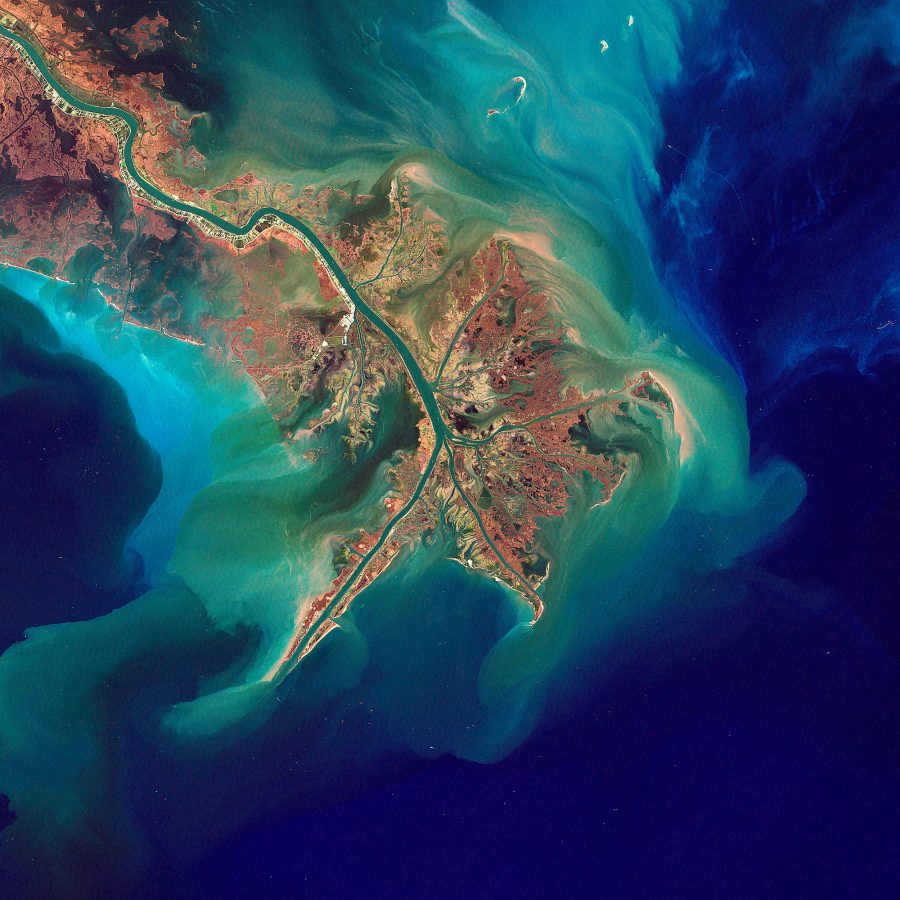
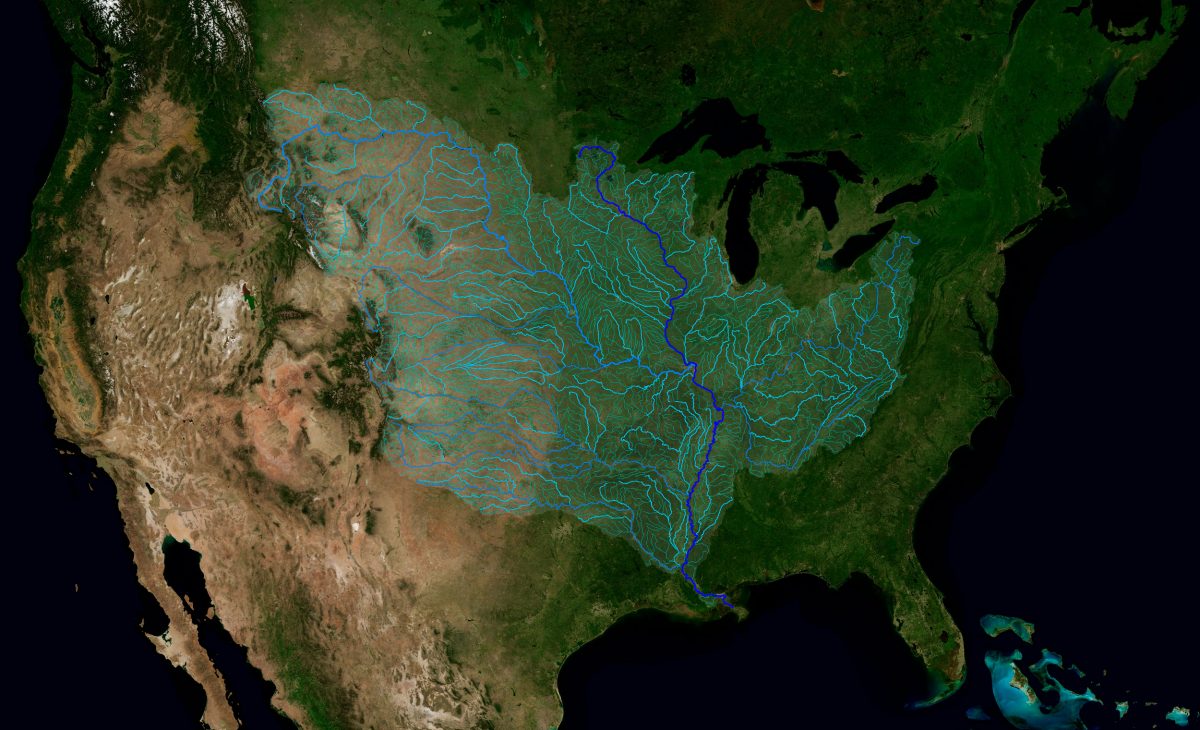
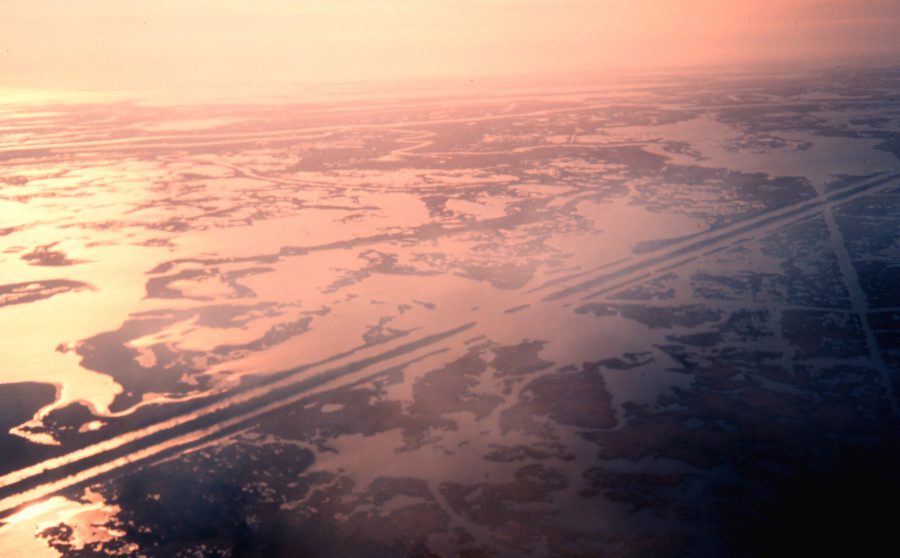

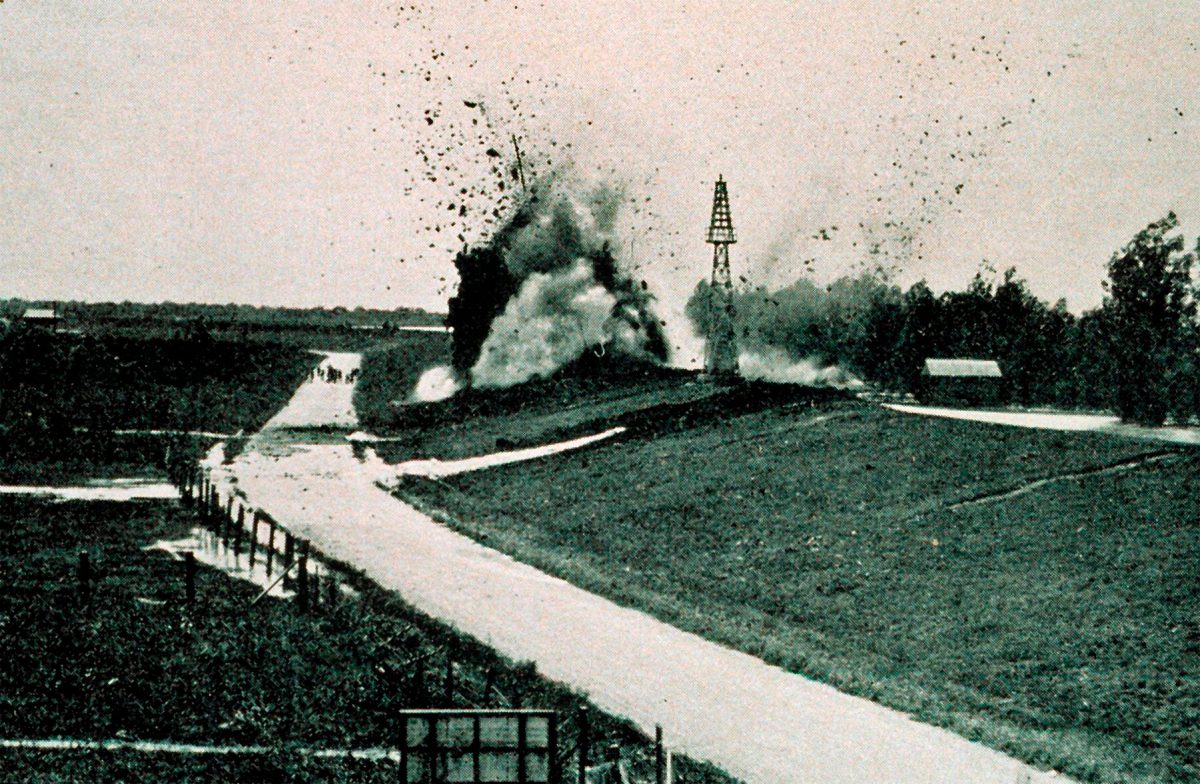

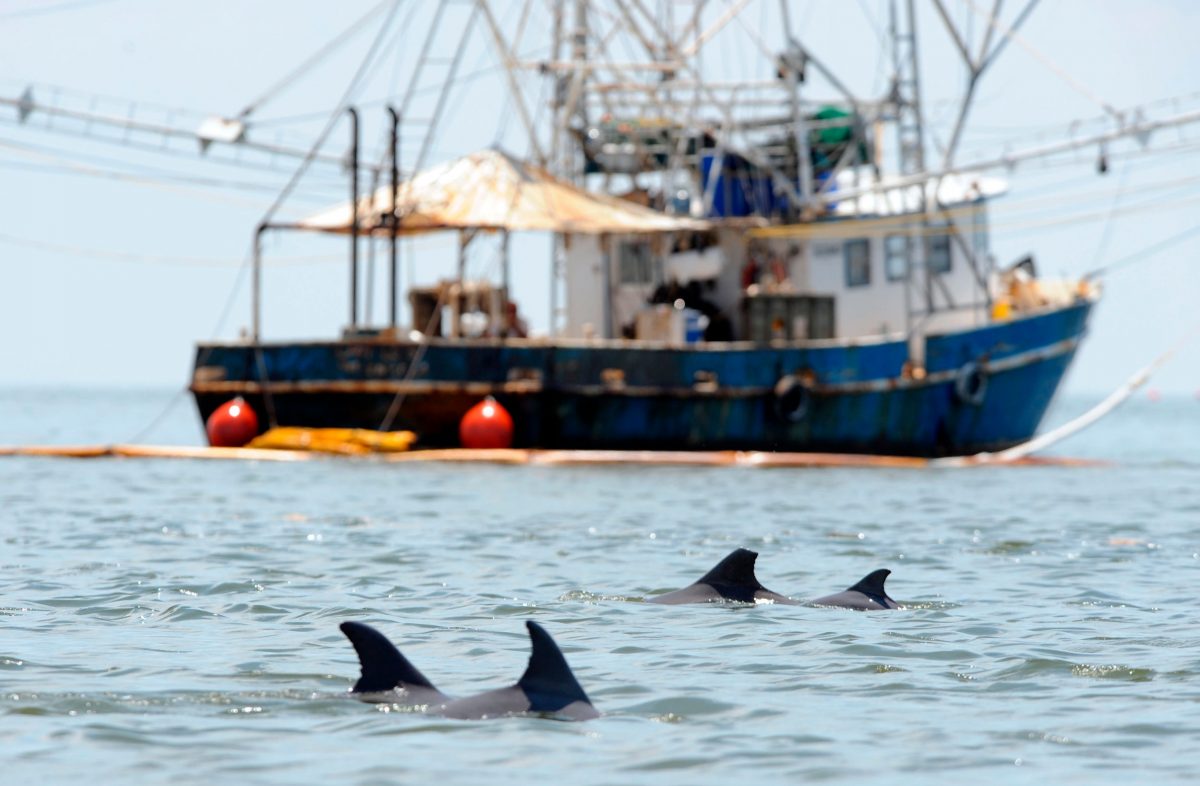

No comments:
Post a Comment